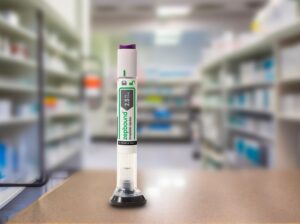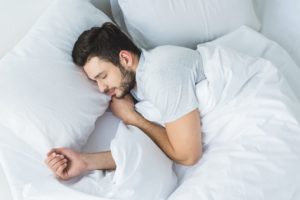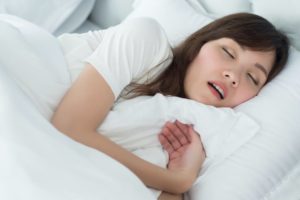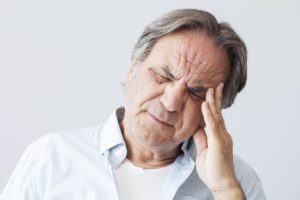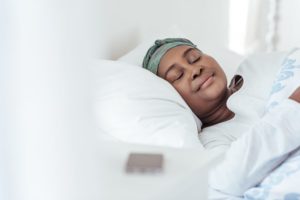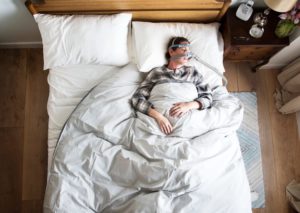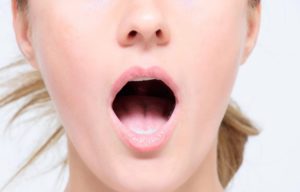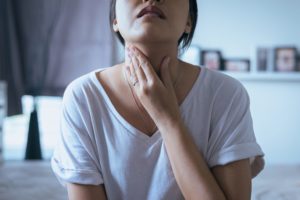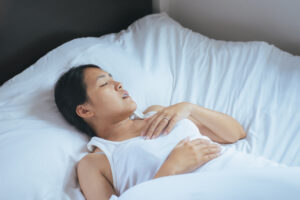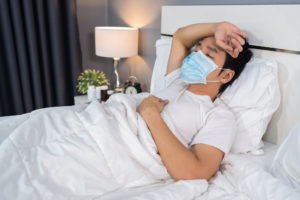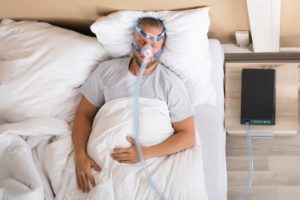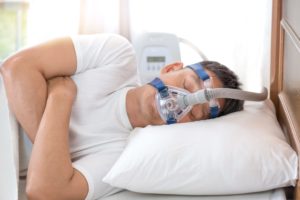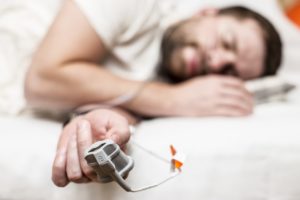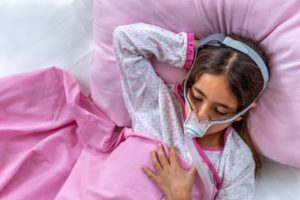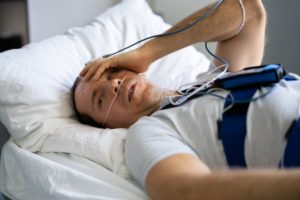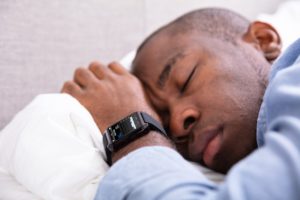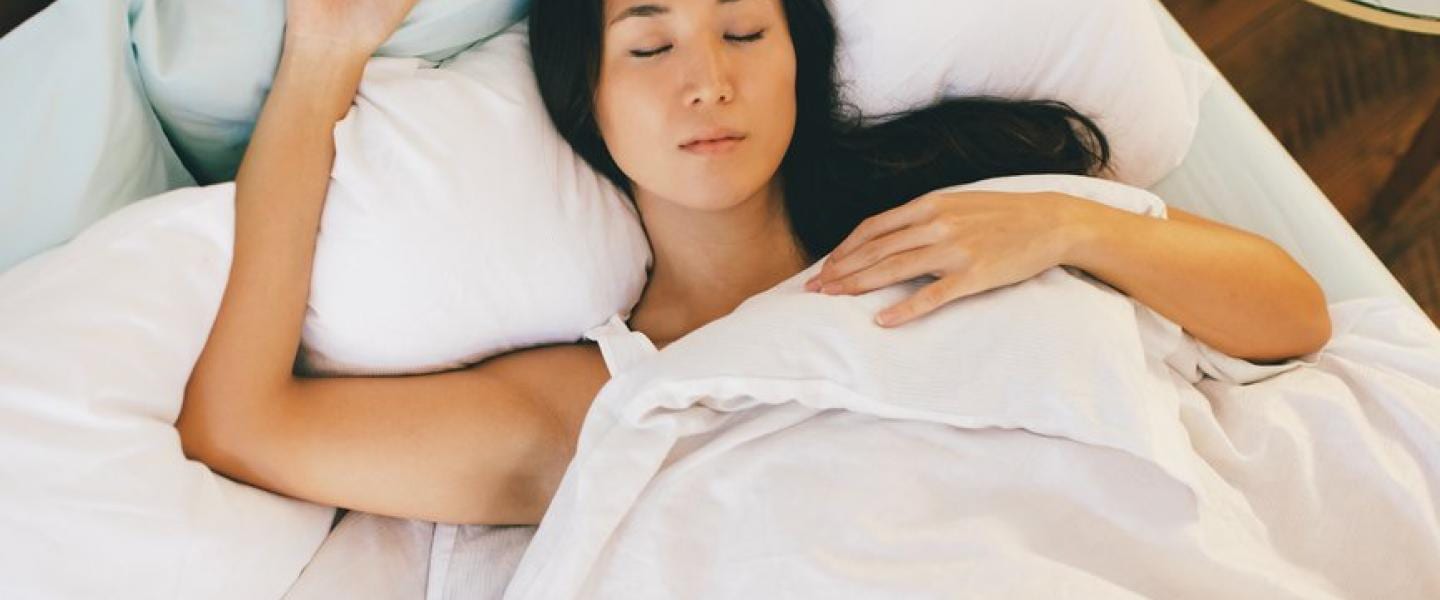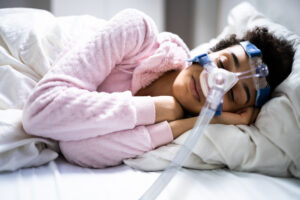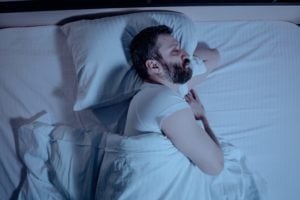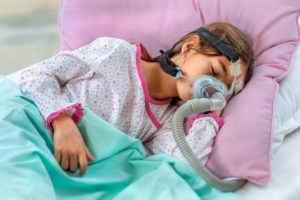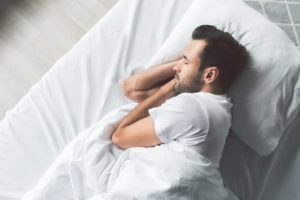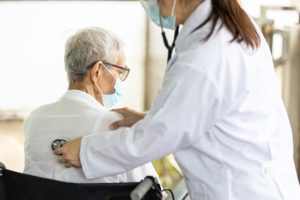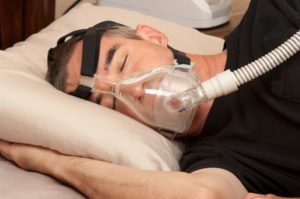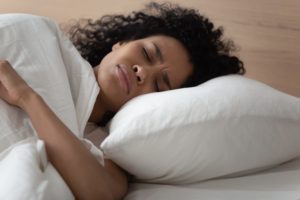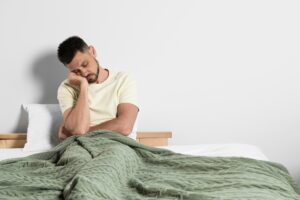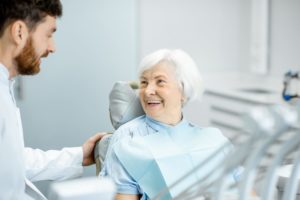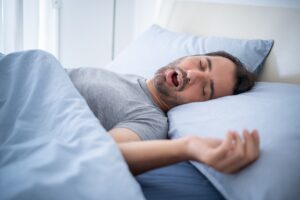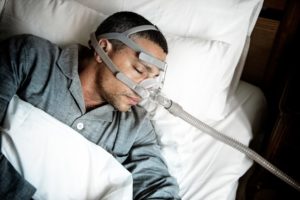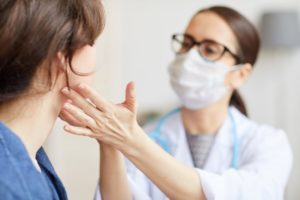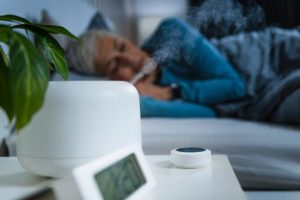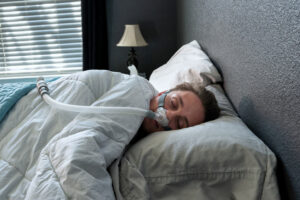When you buy through our links, we may earn a commission. Products or services may be offered by an affiliated entity. Learn more.
Oral Appliances for Sleep Apnea
Treating obstructive sleep apnea (OSA) in those who have it is of utmost importance because of the many risks associated with this disorder. People with OSA stop breathing multiple times throughout the night due to physical blockages of the airway. As a result, they often experience daytime tiredness, headaches, trouble concentrating, and other symptoms. These symptoms may interfere with their work life, relationships, and ability to drive safely. People with OSA also face an increased risk of stroke, heart attack, and high blood pressure, among other issues.
The “gold standard” treatment offered to people with OSA is continuous positive airway pressure (CPAP) therapy, which involves having air blown into the airway to keep it open during sleep. Although CPAP therapy is highly effective, some people have trouble tolerating it. In these instances, other treatments are recommended, such as oral appliances.
What Are Oral Appliances for Sleep Apnea?
Oral appliances are devices put in the mouth to help keep a person’s airway open as they sleep. Two oral appliances are generally used for adults with OSA, and a third is available for children with OSA. People are usually prescribed oral appliances by their sleep specialist, but sometimes they are handled by an orthodontist or dentist. Although these appliances may reduce snoring, they differ from anti-snoring devices available in stores, many of which have not been studied as OSA treatments.
Because they help reduce physical blockages of the airway, oral appliances aren’t used to treat central sleep apnea (CSA). People with CSA experience lapses in breathing as they sleep due to issues with brain stem signaling, not physical airway blockages.
Understand Your Sleep Apnea Risk
Answer three questions to take charge of troubled sleep.
Mandibular Advancement Device (MAD)
A mandibular advancement device (MAD) connects to both the upper and lower teeth in order to advance or move the jaw forward. Sometimes called mandibular advancement splints (MAS), or a mandibular protrusion device , this type of device helps open the upper airway by moving the base of the tongue forward. This oral appliance is designed to be inserted before sleep, then removed in the morning.
MADs look similar to a mouthguard and can be customized to fit the individual or purchased in a stock form. These appliances come in multiple variations in terms of materials, shape, and color. Some are one-piece devices, while others have two separate pieces for the upper and lower teeth. The two-piece devices generally connect in some way, and some are adjustable in terms of how far they extend the jaw.
Research shows that MADs effectively treat OSA . In addition to decreasing the number of lapses in breathing per night, these devices reduce snoring volume, snoring frequency, and daytime sleepiness. Generally, MADs do not monitor usage or symptoms, as CPAP machines do, but a “smart” MAD that monitors breathing and heart rate is in development.
A MAD can produce some side effects, though they usually aren’t serious. A person sleeping with a MAD device might initially find they produce extra saliva or experience dry mouth or gums. These symptoms generally pass with time, though some people experience more lasting symptoms, like pain and changes in how the teeth meet.
Tongue-Stabilizing Device (TSD)
Tongue-stabilizing devices (TSDs), also called tongue-retaining devices, pull the tongue forward using suction. The tip of the tongue then sits in a plastic bulb, protruding through the lips. Moving the tongue forward is intended to help keep the tongue base from blocking the airway. These are usually stock, one-size-fits-all devices, but some may be customized to an individual’s mouth.
Although TSDs haven’t been as widely studied as MADs, research suggests they reduce lapses in breathing and improve daytime tiredness. Still, studies show that up to 90% of people with OSA prefer MADs over TSDs.
Rapid Maxillary Expansion (RME)
In children with OSA, rapid maxillary expansion (RME) is a potential orthodontic device treatment that opens the airway by expanding the roof of the mouth . RME involves wearing a custom-fitted expander that fits over top back teeth. There are multiple expander types, but all involve using pressure that pushes outwards against the upper molars. Unlike other oral appliances, RMEs are worn at all times, not only at night. Instead of temporarily clearing the airway, they aim to permanently adjust the anatomy of children who have narrow or highly arched hard palates.
Studies show that RME reduces symptoms in most children and cures OSA in about 25% of the children who receive it. One review of multiple studies concluded that combining surgeries , like tonsil removal and adenoid removal, with an orthodontic treatment like RME is more effective than either treatment type on its own.
How Does Oral Appliance Therapy Work to Treat Sleep Apnea?
Oral appliance therapy treats sleep apnea by helping remove physical blockages from the upper airway. Mandibular advancement devices (MADs) help clear the airway by moving the jaw forward, while tongue-stabilizing devices (TSDs) help clear the airway by moving the tongue forward. In children, rapid maxillary expansion (RME) devices help clear the airway by permanently expanding the width of the roof of the mouth.

How Does Oral Appliance Therapy Compare to Other Treatment Options for Sleep Apnea?
Research shows oral appliance therapies generally do not treat obstructive sleep apnea (OSA) as well as continuous positive airway pressure (CPAP) therapy . CPAP therapy performs better than both mandibular advancement devices and tongue-retaining devices when it comes to treating OSA.
CPAP therapy is usually the first OSA treatment option offered to adults because of its 95% efficacy rate. However, oral appliances may be more effective in a real-world setting because some people are more likely to use them. CPAP only has a 40% compliance rate over the long term because some people cannot easily tolerate sleeping with a CPAP machine. However, mandibular advancement devices have an 80% compliance rate, and many people report preferring them over CPAP.
Although tongue-retaining devices seem to be as effective as mandibular advancement devices, 90% of people prefer mandibular advancement devices over tongue-retaining devices. This preference likely accounts for why mandibular advancement devices are usually the second OSA treatment considered after CPAP.
In children, removing the tonsils and adenoids is generally the first-line OSA therapy because it is the most effective. CPAP therapy can help treat OSA in children, but compliance with CPAP is even worse in children than in adults. Orthodontist treatments like rapid maxillary expansion can be very effective, either alone or in combination with surgery.
Who Are Oral Appliances for Sleep Apnea Best For?
Experts suggest oral appliances for sleep apnea as a treatment for adults who cannot tolerate CPAP therapy , and those who snore but do not have OSA.
A rapid maxillary expansion device might be considered as a treatment for children with mild or moderate OSA, in those with severe OSA experiencing symptoms that persist after surgery removal the tonsils and adenoids, or in children with OSA who clearly have a narrow or highly arched hard palate.
Talking to Your Doctor About Oral Appliances for Sleep Apnea
Oral appliances might be a good option for you if you have been diagnosed with obstructive sleep apnea and have trouble using a CPAP machine. Instead of setting your CPAP aside and going untreated, talk to your doctor about the possibility of trying oral appliances, like a mandibular advancement device or tongue-retaining device.
If you have a child with obstructive sleep apnea, talk to their doctor about oral appliances as a potential treatment. Although removing the tonsils and adenoids is the standard treatment, sometimes an oral appliance can work instead, or can be useful after surgery if symptoms persist. People who use oral appliances might experience some adverse effects, like discomfort or pain, dry mouth, excessive saliva, or adjustments in tooth placement.

Still have questions? Ask our community!
Join our Sleep Care Community — a trusted hub of sleep health professionals, product specialists, and people just like you. Whether you need expert sleep advice for your insomnia or you’re searching for the perfect mattress, we’ve got you covered. Get personalized guidance from the experts who know sleep best.
References
15 Sources
-
García, N. M., Blaya, F., Urquijo, E. L., Heras, E. S., & D’Amato, R. (2019). Oral appliance for obstructive sleep apnea: Prototyping and optimization of the mandibular protrusion device. Journal of Medical Systems, 43(5), 107.
https://pubmed.ncbi.nlm.nih.gov/30887223/ -
Ng, J. H., & Yow, M. (2019). Oral appliances in the management of obstructive sleep apnea. Sleep Medicine Clinics, 14(1), 109–118.
https://pubmed.ncbi.nlm.nih.gov/30709525/ -
Kaur, A., Chand, P., Singh, R. D., Siddhartha, R., Tripathi, A., Tripathi, S., Singh, R., & Mishra, A. (2012). Computed tomographic evaluation of the effects of mandibular advancement devices on pharyngeal dimension changes in patients with obstructive sleep apnea. The International Journal of Prosthodontics, 25(5), 497–505.
https://pubmed.ncbi.nlm.nih.gov/22930773/ -
Nabavi, S., Debbarma, S., & Bhadra, S. (2020). A smart mandibular advancement device for intraoral cardiorespiratory monitoring. Annual International Conference of the IEEE Engineering in Medicine and Biology Society, 2020, 4079–4084.
https://pubmed.ncbi.nlm.nih.gov/33018895/ -
Chang, E. T., Fernandez-Salvador, C., Giambo, J., Nesbitt, B., Liu, S. Y., Capasso, R., Kushida, C. A., & Camacho, M. (2017). Tongue retaining devices for obstructive sleep apnea: A systematic review and meta-analysis. American Journal of Otolaryngology, 38(3), 272–278.
https://pubmed.ncbi.nlm.nih.gov/28237516/ -
Camacho, M., Chang, E. T., Song, S. A., Abdullatif, J., Zaghi, S., Pirelli, P., Certal, V., & Guilleminault, C. (2017). Rapid maxillary expansion for pediatric obstructive sleep apnea: A systematic review and meta-analysis. The Laryngoscope, 127(7), 1712–1719.
https://pubmed.ncbi.nlm.nih.gov/27796040/ -
Agarwal, A., & Mathur, R. (2010). Maxillary expansion. International Journal of Clinical Pediatric Dentistry, 3(3), 139–146.
https://pubmed.ncbi.nlm.nih.gov/27616835/ -
Templier, L., Rossi, C., Miguez, M., Pérez, J. D., Curto, A., Albaladejo, A., & Vich, M. L. (2020). Combined surgical and orthodontic treatments in children with OSA: A systematic review. Journal of Clinical Medicine, 9(8), 2387.
https://pubmed.ncbi.nlm.nih.gov/32722638/ -
Mickelson, S. A. (2020). Oral appliances for snoring and obstructive sleep apnea. Otolaryngologic Clinics of North America, 53(3), 397–407.
https://pubmed.ncbi.nlm.nih.gov/32223982/ -
Li, P., Ning, X. H., Lin, H., Zhang, N., Gao, Y. F., & Ping, F. (2020). Continuous positive airway pressure versus mandibular advancement device in the treatment of obstructive sleep apnea: A systematic review and meta-analysis. Sleep Medicine, 72, 5–11.
https://pubmed.ncbi.nlm.nih.gov/32534403/ -
Banhiran, W., Durongphan, A., Keskool, P., Chongkolwatana, C., & Metheetrairut, C. (2020). Randomized crossover study of tongue-retaining device and positive airway pressure for obstructive sleep apnea. Sleep & Breathing = Schlaf & Atmung, 24(3), 1011–1018.
https://pubmed.ncbi.nlm.nih.gov/31754961/ -
Mohammadieh, A., Sutherland, K., & Cistulli, P. A. (2017). Sleep disordered breathing: Management update. Internal Medicine Journal, 47(11), 1241–1247.
https://pubmed.ncbi.nlm.nih.gov/29105265/ -
Sánchez-Súcar, A. M., Sánchez-Súcar, F. B., Almerich-Silla, J. M., Paredes-Gallardo, V., Montiel-Company, J. M., Gara-Sanz, V., & Bellot-Arcís, C. (2019). Effect of rapid maxillary expansion on sleep apnea-hypopnea syndrome in growing patients. A meta analysis. Journal of Clinical and Experimental Dentistry, 11(8), e759–e767.
https://pubmed.ncbi.nlm.nih.gov/31598206/ -
Hawkins, S. M., Jensen, E. L., Simon, S. L., & Friedman, N. R. (2016). Correlates of pediatric CPAP adherence. Journal of Clinical Sleep Medicine, 12(6), 879–884.
https://pubmed.ncbi.nlm.nih.gov/27092702/ -
Ramar, K., Dort, L. C., Katz, S. G., Lettieri, C. J., Harrod, C. G., Thomas, S. M., & Chervin, R. D. (2015). Clinical practice guideline for the treatment of obstructive sleep apnea and snoring with oral appliance therapy: An update for 2015. Journal of Clinical Sleep Medicine, 11(7), 773–827.
https://pubmed.ncbi.nlm.nih.gov/26094920/


